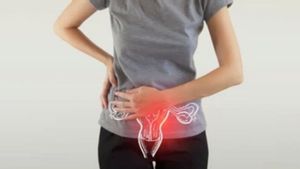YOGYAKARTA – Many women do not realize until old age that they have pelvic organ prolapse. This risk can be experienced by every woman who has given birth. Quoting from Women's Health, Tuesday, June 7, one in three women who have given birth experience incontinence or leakage of urine when laughing, coughing, sneezing, jumping, or while running. While one in ten women experience bowel incontinence, stool, or flatulence.
In their lifetime, as many as 50 percent of women who have babies will experience some degree of prolapse at various stages in their lives. Therefore, it is important to be aware of and take preventive measures early on so as not to experience this risk.
The pelvic floor is made up of a layer of muscle and other tissue that extends from the tailbone to the pubic bone. The pelvic floor muscles in women support the bladder, uterus, and intestines. Its function is to control all three and play an important role in sexual function. So it is very important to keep the pelvic floor muscles functioning properly. However, if these muscles are not properly cared for, they become disturbed during pregnancy, birth, the postnatal period, and the menopause.

If the pelvic floor muscles are disturbed, you can experience bowel and or bladder incontinence in the long term. In addition, there is also a risk of prolapse, decreased support for the contents of the pelvis, decreased support for the lower back, and a significant impact on a person's physical and mental health. The good news is that women with incontinence or pelvic floor prolapse can be trained and return to normal.
Pelvic floor prolapse (POP) is a condition where the pelvic organs descend. The pelvic organs are held in position by fascia and ligaments which also help to connect the pelvic organs to the side walls of the pelvic bones. When the supporting tissue is torn or stretched resulting in herniation of these organs into or through the vagina or anal canal.
The severity of POP ranges from grades one to four. Mild prolapse can be managed with pelvic floor therapy, good nutrition, good urination habits, proper exercise, and sometimes the use of a pessary or ankle brace.
VOIR éGALEMENT:
Women at risk for pelvic floor dysfunction include:
- Have been pregnant
- Long delivery, more than two hours
- Rapid delivery
- Baby weighing more than four kilograms
- Childbirth with forceps and vacuum
- Overweight One or more pregnancies and vaginal delivery
- Ever had chronic constipation or frequent bowel movements
- Menopause
Pelvic floor muscle dysfunction, can be identified when you feel heavy or bulging in the vagina, there is a lump protruding from the vagina, pain during sex, recurrent urinary tract infections, incontinence, difficulty emptying the bowel and bladder, and urine dripping after urinating.
Each woman who experiences this has varying symptoms. But there's no need to panic if you experience any of the most common POP symptoms mentioned above. If you experience this, you can consult a specialist so that you can get the right recommendations.
The English, Chinese, Japanese, Arabic, and French versions are automatically generated by the AI. So there may still be inaccuracies in translating, please always see Indonesian as our main language. (system supported by DigitalSiber.id)


















